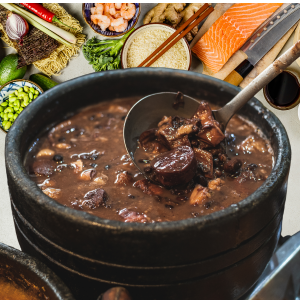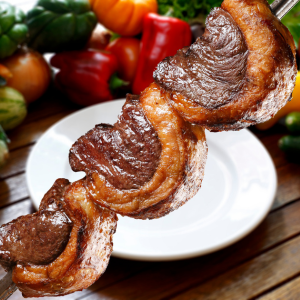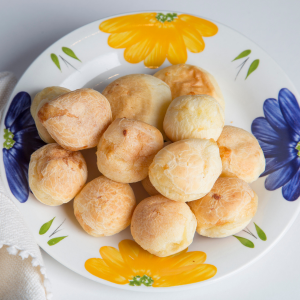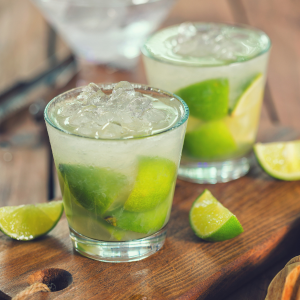Popular Food and Drink in Brazil is a tantalizing fusion of flavors, a vibrant palette of tastes that mirrors the nation's kaleidoscope of cultures and landscapes. As a sprawling mosaic of customs and colors, Brazil's culinary landscape transforms from one region to the next, a testament to the rich tapestry woven by its diverse heritage and expansive geography. From the bustling streets of Rio de Janeiro to the serene corners of the Amazon rainforest, each locale brings its own unique ingredients and techniques to the table, crafting a gastronomic journey that is as thrilling as it is diverse.
This article delves into the heart of Brazil's kitchens, uncovering the mouthwatering traditions that define its culinary identity. Join us as we embark on a delectable voyage through the delectable world of Brazilian cuisine.
Top popular food and drink in Brazil
- What is traditional Brazilian food?
These traditional Brazilian dishes encapsulate the heart and soul of Brazilian cuisine, offering a tantalizing array of flavors and textures deeply intertwined with the nation's history and culture, let's expand on these popular Brazilian dishes:
1. Feijoada: The National Dish
- Origins and history of Feijoada
Feijoada traces its roots back to the time of Portuguese colonization in Brazil. It evolved from the tradition of preparing stews with beans, and over the centuries, it became a beloved national dish.
- Ingredients and preparation
This hearty dish primarily consists of black beans cooked with a variety of pork cuts such as sausage, bacon, and sometimes even pig's ears and tail. It's slow-cooked to perfection, infusing rich, smoky flavors into the beans.
- Significance in Brazilian culture
Feijoada is more than just a meal; it's a cultural symbol. Traditionally served on Saturdays, it brings families and communities together. It's often accompanied by farofa (toasted cassava flour), rice, orange slices, and kale, creating a harmonious blend of textures and flavors.
2. Coxinhas: A Deep-Fried Delight
- Description and origin of Coxinha
Coxinha, which means 'little thigh' in Portuguese, is a delectable snack that resembles a chicken drumstick. It originated in São Paulo in the late 19th century and quickly gained popularity across Brazil.
- Filling variations and preparation process
The core of coxinha is a succulent filling typically made from shredded chicken, seasoned and cooked to perfection. This is encased in a dough made from wheat flour, and filled with a creamy mixture of chicken, cheese, and sometimes vegetables. It's then breaded and deep-fried to a golden crisp.
- Popularity in Brazilian street food culture
Coxinha is a staple in Brazilian street food culture, found in virtually every corner of the country. Its convenient handheld form makes it a favorite on-the-go snack for locals and tourists alike.
3. Açaí Bowl: A Superfood Sensation
- Introduction to Açaí and its health benefits
Açaí is a purple berry indigenous to the Amazon rainforest, celebrated for its high levels of antioxidants, fiber, and healthy fats. It has gained international acclaim as a superfood.
- How Acai bowls are prepared?
Açaí bowls are crafted by blending frozen açaí pulp with a liquid (often coconut water or milk) to create a thick, smoothie-like consistency. It's then topped with an assortment of fruits, granola, and sometimes honey or nuts for added flavor and texture.
- Açaí's popularity as a breakfast choice
In Brazil, açaí bowls have become a popular breakfast option due to their nourishing properties. They provide a refreshing burst of energy, making them an ideal start to the day, especially in warmer regions.
4. Moqueca: A Seafood Spectacle
- Origins and Regional Variations of Moqueca
Moqueca hails from the coastal regions of Brazil, with variations found in both the Northeast and Southeast. Its origins can be traced back to Indigenous and Afro-Brazilian culinary traditions.
- Key ingredients and cooking methods
This flavorful stew revolves around fresh seafood, typically fish or shrimp, slow-cooked in a fragrant broth made from coconut milk, dendê oil (palm oil), tomatoes, peppers, and aromatic herbs and spices.
- Cultural importance of Moqueca in coastal regions
Moqueca embodies the coastal way of life, encapsulating the bounties of the sea. It's a dish often shared with loved ones during festive gatherings, forging connections between communities and honoring their maritime heritage.
5. Picanha: Barbecued meat
Barbecue, Commonly referred to as "churrasco" in Brazil, is renowned for its exceptional flavor and tenderness. This prime cut of beef, also known as the top sirloin cap, is characterized by its distinctive triangular shape and a thick layer of fat that adds a luxurious richness to the meat when cooked. The preparation of picanha is relatively straightforward, often involving minimal seasoning with just rock salt to allow the natural flavors to shine. When grilled over an open flame, the fat cap bastes the meat, infusing it with a succulent, smoky essence. The result is a juicy, melt-in-your-mouth experience that embodies the essence of Brazilian barbecue.
Picanha is a centerpiece of churrascarias, where skilled "churrasqueiros" expertly cook and serve this prized cut to eager diners. Its popularity extends beyond Brazil, making picanha a beloved culinary treasure celebrated worldwide. This exquisite cut of meat exemplifies the mastery and artistry that defines Brazilian barbecue, making it an integral part of the nation's rich gastronomic heritage.
6. Pão de Queijo - Brazilian Bread
- What is Brazil most consumed food?
Pão is the Portuguese word for bread, and it holds a central place in Brazilian cuisine. It is a staple food item consumed in various forms and plays a significant role in daily meals. In Brazil, pão comes in different shapes and sizes, ranging from traditional baguettes to smaller rolls known as "pãezinhos". It's a versatile component of many dishes, often used to make sandwiches or as an accompaniment to meals.
Additionally, pão de queijo, a type of cheese bread made from cassava flour and cheese, is an iconic Brazilian snack enjoyed across the country. Pão's cultural significance is evident in the numerous bakeries, or "padarias", that are ubiquitous in Brazilian cities and towns, offering a wide array of bread varieties. This widespread love for pão reflects the integral role it plays in Brazilian gastronomy, making it a comforting and essential part of daily life.
Brazilian Sweets and Desserts
These Brazilian sweets and desserts not only tantalize the taste buds but also serve as cultural touchstones, woven into the fabric of Brazilian celebrations and traditions.
1. Brigadeiros: The National Sweet Treat
- History and significance of Brigadeiro
Brigadeiro holds a special place in Brazilian hearts as a cherished sweet treat. It emerged in the mid-20th century during political campaigns, where supporters of Brigadier Eduardo Gomes would sell these sweets to raise funds. Over time, it evolved into a national dessert.
- Ingredients and preparation process
Brigadeiro is a simple yet delightful concoction made from condensed milk, cocoa powder, butter, and chocolate sprinkles. These ingredients are combined in a saucepan and cooked until the mixture thickens, before being rolled into bite-sized balls and coated with chocolate sprinkles.
- Its role in Brazilian celebrations
Brigadeiro is a staple at celebrations and gatherings across Brazil. From birthdays to weddings and festivals, these delectable treats are an essential part of any festive spread, adding a touch of sweetness to joyous occasions.
2. Quindim: A Bright Yellow Delight
- Introduction to Quindim and its unique color
Quindim is a visually striking Brazilian dessert known for its vibrant yellow hue. This brilliance is achieved through the inclusion of rich, golden-hued ingredients like egg yolks and sugar.
- Ingredients and traditional preparation
The key components of Quindim are sugar, butter, and a generous quantity of egg yolks. These ingredients are meticulously combined, creating a velvety mixture that's poured into individual molds and baked until it achieves a golden, glossy finish.
- Quindim in Brazilian dessert culture
Quindim graces dessert tables at a multitude of Brazilian gatherings. Its smooth texture and sweet, custard-like flavor make it a beloved treat, particularly during special occasions like birthdays, weddings, and holidays.
3. Canjica: A Warming Winter Dessert
- Origins of Canjica and its association with Festa Junina
Canjica has its roots in Brazilian folklore and is closely linked with Festa Junina, a vibrant festival celebrating rural life. It's believed that this dish, made from white hominy corn, was first prepared to honor the corn harvest.
- Ingredients and cooking process
Canjica is crafted from dried hominy corn kernels, slow-cooked in a creamy mixture of milk, sugar, and aromatic spices like cinnamon. It's a comforting dish, often garnished with toppings like grated coconut or cinnamon for added flavor.
- Canjica's popularity in Brazilian Winter Festivals
Canjica is a cherished winter dessert, offering warmth and sustenance during the colder months. Its presence at Festa Junina is a testament to its cultural significance, symbolizing the bounty of the harvest season and the unity of Brazilian communities.
Brazilian Drinks and Beverages
- What do people drink in Brazil?
These popular Brazilian drinks and beverages not only quench thirst but also provide a window into the cultural tapestry and agricultural prowess of this vibrant nation., let's explore the famous drinks and beverages of Brazil:
1. Caipirinha: Brazil's National Cocktail
- Introduction to Caipirinha and its main ingredients
Caipirinha is Brazil's quintessential cocktail, renowned for its refreshing and zesty flavors. The drink features cachaça (a Brazilian distilled spirit), lime, sugar, and ice. Its simplicity belies the complex interplay of flavors.
- How it's prepared and what variations?
To create a Caipirinha, lime wedges are muddled with sugar, releasing the citrus oils and mingling them with the sweetness. The mixture is then topped with cachaça and ice, creating a harmonious blend of tanginess, sweetness, and the distinct kick of the spirit. Variations often include different fruits, such as passion fruit or berries.
- Social and cultural significance of Caipirinha
Caipirinha embodies the convivial spirit of Brazil. It's the drink of choice for social gatherings, from beach parties to barbecues. Its roots are deeply intertwined with Brazilian culture, reflecting the nation's love for vibrant, refreshing beverages.
2. Guarana: Brazil's Favored Soft Drink
- Overview of Guarana and its origin
Guarana is a fruit native to the Amazon rainforest, renowned for its bright red berries that contain seeds with stimulating properties. Indigenous communities in Brazil have long used guarana for its energy-boosting effects.
- Its popularity as a soft drink and energy booster?
The seeds of the guarana fruit are ground and used to create a popular Brazilian soft drink. It's a natural stimulant, rich in caffeine, and is consumed for its energizing effects. It has become an integral part of Brazilian culture, with various brands producing guarana-flavored beverages.
- Cultural Relevance of Guarana in Brazil
Guarana has transcended its botanical origins to become an icon of Brazilian vitality. It's not only a widely consumed soft drink but also a symbol of the Amazon and the natural resources that are deeply intertwined with Brazilian identity.
3. Coffee: Brazil's Bean Connection
- Brazil's role as a major coffee producer
Brazil is the world's largest exporter of coffee, producing a significant portion of the world's supply. The country's diverse climates and landscapes provide ideal conditions for growing a wide variety of coffee beans.
- Different coffee varieties and their characteristics
Brazil is renowned for producing a range of coffee beans, each with unique flavor profiles. From the bright acidity of beans from Minas Gerais to the full-bodied richness of those from Bahia, Brazil offers a diverse array of coffee experiences.
- Coffee's cultural significance and traditions in Brazil
Coffee holds a revered place in Brazilian culture. It's not just a beverage; it's a ritual. From the cozy cafes of São Paulo to the traditional fazendas (coffee farms) in Minas Gerais, the act of sharing coffee fosters connection and conversation, serving as a cornerstone of Brazilian social life.
The Regional Culinary Highlights of Brazil
Brazil's culinary landscape is a captivating journey through diverse regions, each boasting its own unique flavors and cultural influences. In the Amazon, exotic ingredients like açaí berries and manioc create a vibrant tapestry of flavors deeply rooted in Indigenous and immigrant traditions. The Northeastern states, particularly Bahia, offer a tantalizing array of dishes like Moqueca Baiana and Acarajé, reflecting a rich African heritage. Meanwhile, in the South, European immigration has left an indelible mark, evident in the cherished tradition of Churrasco and dishes like Sopa de Capeletti and Strudel. This regional diversity, shaped by both natural abundance and cultural exchange, exemplifies Brazil's extraordinary culinary heritage.
Conclusion
Popular Food and Drink in Brazil dance from the Amazon's exotic ingredients to the Southern comforts of European-infused dishes, creating a tapestry of tastes as diverse as the nation itself. From Feijoada's hearty embrace to the zesty tang of Caipirinha, every dish and drink tells a story of tradition, fusion, and celebration. This culinary richness isn't just sustenance; it's an integral part of Brazilian culture and identity.










Post a Comment